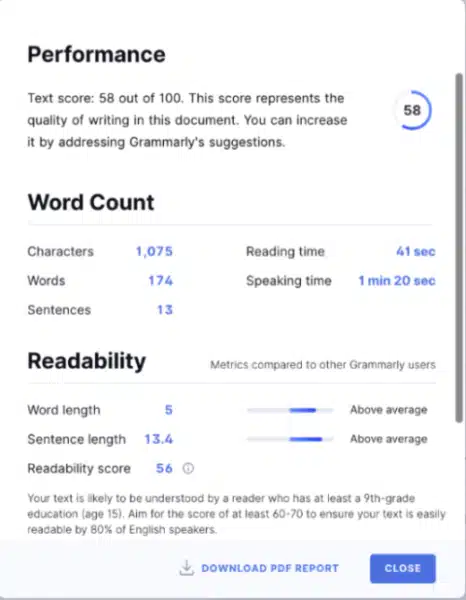[ad_1]
How is your website content performing? What about the blog content you published two months ago? Two years ago?
Does all of this help you achieve your goals? Do you know – or don’t you have a clue?
Then it’s time for a content audit.
What is a content audit? why should you make one
A content audit is a systematic review of your website’s content, including:
- blogs.
- home pages.
- Product or Service Pages.
- core content pages.
This review helps you understand if your content is meeting your goals, including reaching your desired audience.
But that’s not all.
4 benefits of a content audit
1. It shows you what content needs improvement (backed by data)
A content audit not only shows you whether your content is working in general, but also gives you specific pointers to areas that you need to improve.
For example, you may find broken links that you weren’t previously aware of, keyword opportunities that you miss, missing metadata, and other issues that you can easily fix to improve your content’s usability and visibility.
2. It gives you an overall bird’s-eye view of your content
When you have a lot of content on your website, an audit can be a mammoth undertaking. However, conducting a content audit is the only way to sift through your entire content trove and get a true understanding of whether it serves your business… or stays flat.
3. A content audit helps you optimize your content so that it works
Even if you have a very small business and don’t have a lot of content, a content review still makes sense. It will help you optimize the content you have so that it works at its best.
And powerful content is powerful.
- It can convince prospects that your brand is trustworthy: 64% of consumers said they trust a brand after reading educational content from that brand. (Conductor)
- Good content can influence purchasing decisions: consumers are 131% more likely to buy from a brand with effective content. (Conductor)
- Optimized content is a lead machine: it generates three times more leads than traditional marketing, but costs 62% less to maintain. (demand metric)
4. It will improve your future content creation
Because a content audit helps you understand what works and what doesn’t (because you’ll see evidence of both on your site!), you can apply this to your future content creation for better results.
When should a content audit be performed?
Now that you know what a content audit is and why you should conduct one, the next question is when.
When is the best time for a content review?
Consider these scenarios:
- Your website is a few years old and you have never performed a content check before. (You’re probably overdue!)
- You are building a content strategy and want a clear picture of what you are working with.
- You revise your content strategy or redesign your website.
Basic steps of a content audit
How does a content audit work? The basic steps include setting goals, collecting your content and data points, and critically analyzing your discoveries.
Step 1: Set goals
Don’t go into a content review without a clear objective or you won’t know what types of content or data points to focus on. Find out what you want from your content review.
Step 2: Gather, categorize and organize your content
You need a way to compare and contrast your content items, get a bird’s-eye view of the data, and categorize each item based on the action you need to take.
Step 3: Analyze your content
Look at the data and determine which parts you want to update, rewrite, keep or delete.
Step 4: Create a plan based on your insights
Prioritize the content that needs immediate attention and create a plan for how you’ll do updates and rewrites.
Step 6: Adjust your content strategy
What did you learn from your content audit? Factor that into your future content strategy.
Get the daily newsletter search marketers count on.
Content review tools
When you’re ready to do your content inspection, there are a few options for collecting URLs, data, and metrics, and putting it all together for optimal analysis.
Here are some of the tools you may need.
1. A plain old spreadsheet
For a no-frills content review — or for a relatively small site — a simple spreadsheet is a good option.
A table helps you lay out your content information and data in an organized manner, which makes analysis easier.

This is the most cost-effective way to do a content check because you don’t need any special tools other than Microsoft Excel or Google Sheets.
Cons: It can be time-consuming to manually collect all of your data, especially if you have more than a few dozen pieces of content to review.
2. Analysis software
Analytical data is important to your content review. This includes metrics like page views, number of internal links and backlinks, bounce rate, time on page, conversion rate, average position on Google, and more.
You need concrete data about each piece of content so that you can decide what action to take in the future (update, rewrite, delete or leave as is).
If you don’t already track your content performance in a tool like Google Analytics, you can pull your various metrics from SEO tools like Semrush, Ahrefs, or SEO Site Checkup.
3. Content Quality Tools
To help you quantify content quality, you may want to use some of these tools to check your content for readability, grammar and word usage, and reading level.
- Yoast SEO: This tool analyzes your text and provides ratings and suggestions for improving readability.

- grammar: In addition to checking grammar and spelling, the paid version of Grammarly offers a performance score that can help with a content review.

4. A content inventory tool
If you have a large website, you may need to invest in a content inventory tool to make your life easier. These tools use your sitemap to automatically fetch your content URLs and their associated metrics.
A couple of good options are Screaming Frog SEO Spider and Semrush’s Content Audit Tool.
Types of content reviews and their associated goals
While you can certainly audit every piece of content on your site, it’s a better idea to narrow your focus and conduct an audit based on content type and goals.
For example, check all of your blog content, all of your landing pages, all of your product/service pages, or all of your main content pages.
After you’ve selected a content type, decide what goal you’re aiming for with your content review. Here are a few common ones:
1. Goal: SEO
When you approach a content audit with the goal of improving your SEO, you’ll be concerned about how your content is performing in Google. You need to ask yourself if your content is properly optimized for searchers and Search engines. Look at:
- content quality.
- word count.
- Keyword difficulty and search volume.
- Average Google position.
- Organic Pageviews.
- Content structure and keyword optimization. (Are there headers with keywords? How is the article structured? Is the focus keyword optimally placed?)
2. Goal: Better engagement and usability
With the goal of improving engagement and user experience, your content review should focus on how your readers interact with your content—and how you can increase that engagement. Look at:
- Social Shares.
- time on page.
- bounce rate.
- conversions.
- Internal links and/or broken links.
Specifically, look at which parts are getting the most/least engagement and analyze what contributes to that success/failure.
3rd goal: conversion optimization
Another goal you could aim for with a content audit is to see how well your content is converting and identify what needs improvement. You could look at:
- How well your content addresses each stage of the buyer’s journey and whether there are any gaps
- Which pages convert well and which don’t, comparing metrics like:
- time on page.
- bounce rate.
- Exchange rate.
What is a content audit? Answer: A necessary part of your content strategy
Quite simply, a content audit is the only way to understand your content at different levels: below in the weeds and above from a bird’s eye view.
Whether your site is huge or tiny, a content audit can help you understand what you have, what you need, what you don’t need, and actions you can take going forward to ensure your ecosystem of content is contributing to your goals.
Remember, there is no one perfect or set way to conduct a content review. Your audit may change depending on the type of content being analyzed and the goals you hope to achieve by the time the audit is completed. With that in mind, tailor your content review to the needs of your site and content strategy.
Last but not least, don’t neglect regular content audits. One-and-done helps your website/business for a limited time only. As your content continues to grow, you need to be constantly taking snapshots of how it’s performing, constantly tweaking, and correcting course.
Content reviews are an essential part of a well-oiled content strategy – don’t neglect this task and you will see results.
The opinions expressed in this article are those of the guest author and not necessarily those of Search Engine Land. Staff authors are listed here.
New in search engine land

